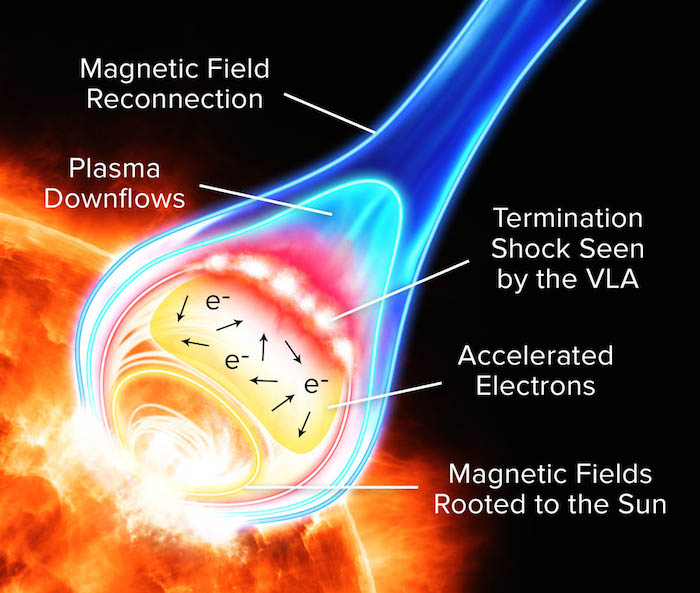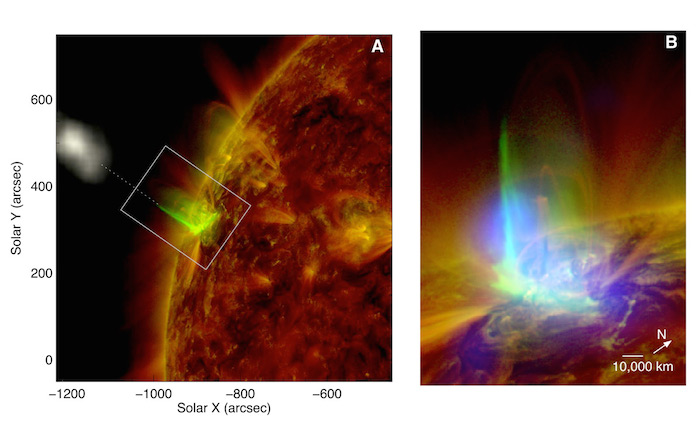.

Cambridge, MA -
Astronomers have made a significant step toward confirming a proposed explanation for how solar flares accelerate charged particles to speeds nearly that of light. This important advance was made possible by the new capabilities of the National Science Foundation's Karl G. Jansky Very Large Array (VLA) radio telescope.
Solar flares, the most powerful explosions in the Solar System, can accelerate large numbers of charged particles like electrons and protons to nearly the speed of light. How they do that, however, has been uncertain.
"It has been thought that a specific type of shock produced by solar flares could be responsible for accelerating these particles, but there has been no convincing observational evidence for this mechanism. Now, using the raw power of the upgraded VLA, we have a fundamentally new result that strongly supports this theoretical scenario," said first author of the study, Bin Chen, of the Harvard-Smithsonian Center for Astrophysics (CfA).
Solar flares are often associated with powerful eruptions that throw huge amounts of material out from the Sun. Scientists think flares are produced by a sudden release of energy from solar magnetic fields. Magnetic fields in the Sun's atmosphere are churned and tangled. An enormous amount of energy is released when those fields snap and reconfigure themselves in a process called magnetic reconnection. Researchers were unclear, though, how the energy release process could propel the high-speed charged particles that emerge from the flares.
The new VLA observations support the idea that the acceleration occurs in a region of the flare where rapidly flowing solar gases impinge on dense magnetic field loops. This creates a shock wave, similar to the sonic boom of an airplane except that it remains in one place as a so-called "termination shock." Electrons are repeatedly pummeled by the shock into higher and higher speeds. The VLA observations of this shock closely match computer simulations that produce such a phenomenon in flares.
The scientists used the VLA, along with other telescopes at ultraviolet and X-ray wavelengths, to study a flare that erupted on 3 March 2012. The VLA can observe the Sun in a broad range of radio frequencies and in time slices of only 50 milliseconds each, producing more than 40,000 individual radio images for one second of observation. The researchers were able to determine that short-lived bursts of radio waves coming from energetic electrons were occurring where the termination shock was expected to be, according to the computer simulations performed by co-author Chengcai Shen, also a researcher at the CfA. Other details further supported the shock acceleration model.
"These new insights are a significant step forward in our understanding of particle acceleration, which is not only an important aspect of solar flares, but also a fundamental physical process occurring throughout the Universe," Chen said.
Quelle: HARVARD-SMITHSONIAN CENTER FOR ASTROPHYSICS
---
VLA Yields New Insights on Solar Flares

The solar flare of 3 March 2012. Left panel, overview of the flare seen at ultraviolet (red and green, showing material at one million and ten million degrees, respectively). The white patch at upper left is the associated solar eruption seen at X-ray. Right Panel, detail (boxed area in left panel) of the flare. Ultraviolet emission is in red and green; radio emission (produced by high-energy particles) seen with the VLA is in blue.
CREDIT: Chen, et al., NRAO/AUI/NSF, NASA.
.
Astronomers have made a significant step toward confirming a proposed explanation for how solar flares accelerate charged particles to speeds nearly that of light. This important advance was made possible by the new capabilities of the National Science Foundation's Karl G. Jansky Very Large Array (VLA) radio telescope.
Solar flares, the most powerful explosions in the Solar System, can accelerate large numbers of charged particles to nearly the speed of light. How they do that, however, has been uncertain.
"It has been thought that a specific type of shock produced by solar flares could be responsible for accelerating these particles, but there has been no convincing observational evidence for this mechanism. Now, using the raw power of the upgraded VLA, we have a fundamentally new result that strongly supports this shock acceleration scenario," said first author of the study, Bin Chen, of the Harvard-Smithsonian Center for Astrophysics.
Solar flares are powerful eruptions that often are associated with coronal mass ejections that throw huge amounts of material out from the Sun. Scientists think they are produced by the sudden release of energy when strong magnetic fields reconfigure themselves and reconnect. Researchers were unclear, though, how such magnetic phenomena could propel the high-speed charged particles that emerge from the eruptions.
The new VLA observations support the idea that the acceleration occurs in a region of the flare where fast plasma flows caused by the violent energy release impinge on dense magnetic loops and form a stationary shock, called a "termination shock." Electrons are repeatedly pummeled by the shock into higher and higher speeds. The VLA results closely match computer simulations that produce such a phenomenon.
The scientists used the VLA, along with other telescopes at ultraviolet and X-ray wavelengths, to study a flare that erupted on 3 March 2012. The VLA produced radio images from a broad range of radio frequencies and in time slices of only 50 milliseconds each. The researchers were able to determine that short-lived bursts of radio waves coming from energetic electrons were occuring where the termination shock was expected to be, according to the computer simulations. Other details further supported the termination-shock acceleration model.
"These new insights are a significant step forward in our understanding of particle acceleration, which is not only an important aspect of solar flares, but also a fundamental physical process occurring throughout the Universe," Chen said.
The VLA was constructed during the 1970s and dedicated in 1980. From 2001 to 2012, the VLA was upgraded to incorporate advanced technology that had been developed since its dedication. Now returned to the technological state of the art, the VLA provides scientists with research capabilities vastly improved over its original design.
"The recently upgraded capabilities of the VLA were absolutely essential in establishing this finding," said co-author Timothy Bastian, of the National Radio Astronomy Observatory.
Chen and Chengcai Shen, of the Harvard-Smithsonian Center for Astrophysics, worked with Bastian, Dale Gary of the New Jersey Institute of Technology, Sam Krucker of the University of California, Berkeley and the University of Applied Science and Arts of Northwestern Switzerland, and Lindsay Glesener, of the University of California, Berkeley and the University of Minnesota. The scientists reported their findings in the 4 December issue of the journal Science.
The National Radio Astronomy Observatory is a facility of the National Science Foundation, operated under cooperative agreement by Associated Universities, Inc.
Quelle: NRAO
4675 Views
